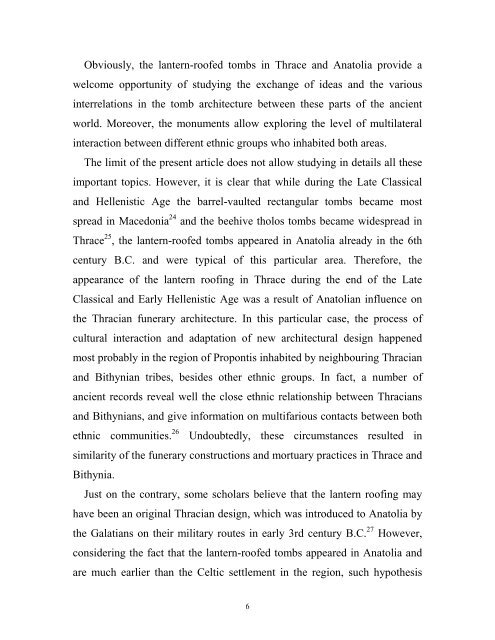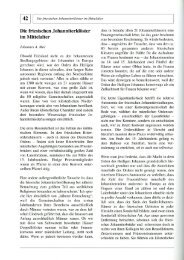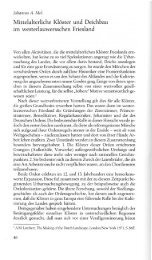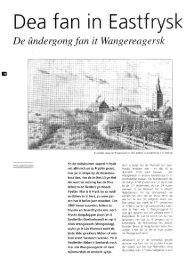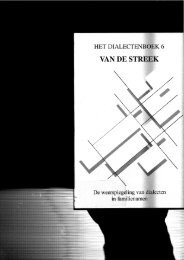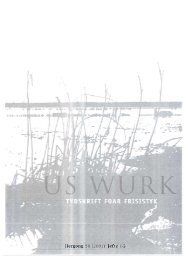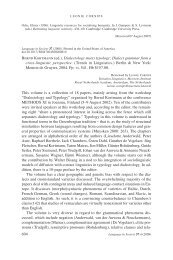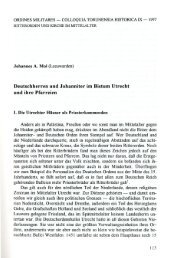The Lantern-Roofed Tombs in Thrace and Anatolia: Some Evidence ...
The Lantern-Roofed Tombs in Thrace and Anatolia: Some Evidence ...
The Lantern-Roofed Tombs in Thrace and Anatolia: Some Evidence ...
You also want an ePaper? Increase the reach of your titles
YUMPU automatically turns print PDFs into web optimized ePapers that Google loves.
Obviously, the lantern-roofed tombs <strong>in</strong> <strong>Thrace</strong> <strong>and</strong> <strong>Anatolia</strong> provide a<br />
welcome opportunity of study<strong>in</strong>g the exchange of ideas <strong>and</strong> the various<br />
<strong>in</strong>terrelations <strong>in</strong> the tomb architecture between these parts of the ancient<br />
world. Moreover, the monuments allow explor<strong>in</strong>g the level of multilateral<br />
<strong>in</strong>teraction between different ethnic groups who <strong>in</strong>habited both areas.<br />
<strong>The</strong> limit of the present article does not allow study<strong>in</strong>g <strong>in</strong> details all these<br />
important topics. However, it is clear that while dur<strong>in</strong>g the Late Classical<br />
<strong>and</strong> Hellenistic Age the barrel-vaulted rectangular tombs became most<br />
spread <strong>in</strong> Macedonia 24 <strong>and</strong> the beehive tholos tombs became widespread <strong>in</strong><br />
<strong>Thrace</strong> 25 , the lantern-roofed tombs appeared <strong>in</strong> <strong>Anatolia</strong> already <strong>in</strong> the 6th<br />
century B.C. <strong>and</strong> were typical of this particular area. <strong>The</strong>refore, the<br />
appearance of the lantern roof<strong>in</strong>g <strong>in</strong> <strong>Thrace</strong> dur<strong>in</strong>g the end of the Late<br />
Classical <strong>and</strong> Early Hellenistic Age was a result of <strong>Anatolia</strong>n <strong>in</strong>fluence on<br />
the Thracian funerary architecture. In this particular case, the process of<br />
cultural <strong>in</strong>teraction <strong>and</strong> adaptation of new architectural design happened<br />
most probably <strong>in</strong> the region of Propontis <strong>in</strong>habited by neighbour<strong>in</strong>g Thracian<br />
<strong>and</strong> Bithynian tribes, besides other ethnic groups. In fact, a number of<br />
ancient records reveal well the close ethnic relationship between Thracians<br />
<strong>and</strong> Bithynians, <strong>and</strong> give <strong>in</strong>formation on multifarious contacts between both<br />
ethnic communities. 26 Undoubtedly, these circumstances resulted <strong>in</strong><br />
similarity of the funerary constructions <strong>and</strong> mortuary practices <strong>in</strong> <strong>Thrace</strong> <strong>and</strong><br />
Bithynia.<br />
Just on the contrary, some scholars believe that the lantern roof<strong>in</strong>g may<br />
have been an orig<strong>in</strong>al Thracian design, which was <strong>in</strong>troduced to <strong>Anatolia</strong> by<br />
the Galatians on their military routes <strong>in</strong> early 3rd century B.C. 27 However,<br />
consider<strong>in</strong>g the fact that the lantern-roofed tombs appeared <strong>in</strong> <strong>Anatolia</strong> <strong>and</strong><br />
are much earlier than the Celtic settlement <strong>in</strong> the region, such hypothesis<br />
6


